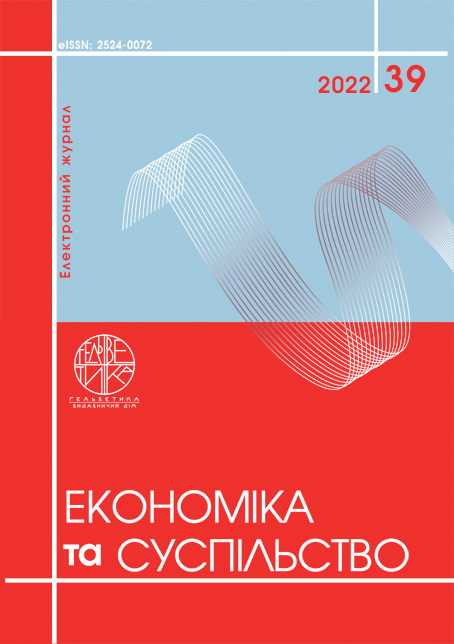MODERN FACTORS OF CANGES IN THE EMPLOYMANT SYSTEM OF UKRAINE
Abstract
The article is devoted to topical issues of determining the current factors of change in the employment system of Ukraine. The factors of formation of affective demand and supply of labor are analyzed and systematized. The necessity of ensuring the interaction of effective supply and demand of forming effective employment is substantiated. Factors at the micro-, meso-, macro- and international levels have been studied. It is substantiated that the factor that simultaneously affects the supply and demand of labor is wages, which to some extent can ensure their coherence and play an important role in shaping effective employment. Innovative factors of effective employment have been identified and structured, which are based on the approach of society, the state and business. The necessity of formation of innovative motivational programs for employees, fair remuneration for participation in innovative projects, development of intellectual potential of the employee, substantiation of joint innovative values of the employer and the employee are established. It is established that only a factor-oriented policy of forming effective employment in the labor market can be effective. The process of forming effective employment is a multifactorial phenomenon. Common factors in the formation of effective demand in terms of innovative change are: natural, industrial, psychological, organizational, socio-economic and regulatory factors. At the macro- level, they include: the state of economic conditions in the country, the dynamics of investing in the economy, the possibility of replacing labor with capital, state policy, the state of social and labor legislation in the country. At the meso- and mіcro- levels, the factors of effective demand include: wages, labor productivity dynamics, demand for goods and services, replacement of labor by other factors of production, number of employers in the industry, age structure of the working population, expansion of production in individual enterprises or industries.
References
Грішнова О.А. Людський капітал: формування в системі освіти і професійної підготовки. Київ : Вид-во “Знання”, 2001. 254 с.
Гуць М. Оцінка стану ринку праці в умовах реформування економіки України. Україна: аспекти праці. 2005. № 2. С. 13–17.
Ільїч Л.М. Інноваційна модель зайнятості: сутність, характерні ознаки та передумови становлення в Україні. Ринок праці та зайнятість населення. 2015. № 2 (43). С. 13–18.
Ільїч Л.М. Продуктивна зайнятість як передумова подолання бідності серед працюючого населення. Соціально-трудові відносини: теорія та практика. 2015. № 1. C. 96–105.
Колот А. Герасименко О. Сфера праці в умовах глобальної соціоекономічної реальності 2020: виклики для України. Київ : “Фрідріх Еберт”, 2020. 36 с.
Колот А.М., Кравчук О.І. Економічно активна людина у новій економіці: теоретико-методологічний аналіз трансформаційних процесів. Ринок праці та зайнятість населення. 2015. № 2 (43). С. 3–9.
Лібанова Е. Україна: Глибина нерівності. Дзеркало тижня. 2016. Вип. 35. URL: https://dt.ua/internal/ukrayina-glibina-nerivnosti-_.html (дата звернення: 08.02.2021).
Лісогор Л.С. Трансформація ринку праці: можливості реалізації інноваційних змін в сучасних умовах. Вісник Прикарпатського університету. 2015. Вип. 11. С. 177–183.
Петрова І.Л. Ринок праці України: суперечності функціонування і перспективи розвитку. Україна: аспекти праці. 2016. № 3–4. С. 3–9.
Тютюнникова С.В., Шпак И.А. Расширенное воспроизводство человеческого капитала как фактор устойчивого развития. Бізнес інформ. 2020. № 4. С. 471–478.
Статистичний щорічник України за 2020 рік / Державна служба статистики України. 2020. 463 с.
Hrishnova O.A. (2001) Lyudsʹkyy kapital: formuvannya v systemi osvity i profesiynoyi pidhotovky [Human capital: formation in the system of education and training]. Kyiv: Znannya. (in Ukrainian)
Hutsʹ M. (2005) Otsinka stanu rynku pratsi v umovakh reformuvannya ekonomiky Ukrayiny [Assessment of the state of the labor market in terms of reforming the economy of Ukraine]. Ukrayina: aspekty pratsi – Ukraine: aspects of work, 2, 13–17. (in Ukrainian)
Ilʹyich L.M. (2015) Innovatsiyna modelʹ zaynyatosti: sutnistʹ, kharakterni oznaky ta peredumovy stanovlennya v Ukrayiny [Innovative model of employment: essence, characteristic features and preconditions of formation in Ukraine]. Rynok pratsi ta zaynyatistʹ naselennya – Labor market and employment, 2 (43), 13–18. (in Ukrainian)
Ilʹyich L.M. (2015) Produktyvna zaynyatistʹ yak peredumova podolannya bidnosti sered pratsyuyuchoho naselennya [Productive employment as a prerequisite for overcoming poverty among the working population]. Sotsialʹno-trudovi vidnosyny: teoriya ta praktyka – Social and labor relations: theory and practice, 1, 96–105. (in Ukrainian)
Kolot A., Herasymenko O. (2020) Sfera pratsi v umovakh hlobalʹnoyi sotsioekonomichnoyi realʹnosti 2020: vyklyky dlya Ukrayiny [The sphere of work in the conditions of the global socio-economic reality 2020: challenges for Ukraine] Kyiv: Friedrich Ebert Retrieved from: https://library.fes.de/pdf-files/bueros/ukraine/16344.pdf (in Ukrainian)
Kolot A.M., Kravchuk O.I. (2015) Ekonomichno aktyvna lyudyna u noviy ekonomitsi: teoretyko-metodolohichnyy analiz transformatsiynykh protsesiv [Economically active person in the new economy: theoretical and methodological analysis of transformation processes]. Rynok pratsi ta zaynyatistʹ naselennya – Labor market and employment, 2(43), 3–9. (in Ukrainian)
Libanova E. (2016) Ukrayina: Hlybyna nerivnosti [Ukraine: Depth of inequality]. Dzerkalo tyzhnya – Mirror of the week, 35. Retrieved from https://dt.ua/internal/ukrayina-glibina-nerivnosti-_.html (in Ukrainian)
Lisohor L.S. (2015) Transformatsiya rynku pratsi: mozhlyvosti realizatsiyi innovatsiynykh zmin v suchasnykh umovakh [Labor market transformation: opportunities for innovative changes in modern conditions]. Visnyk Prykarpat·sʹkoho universytetu – Bulletin of the Precarpathian University, 11, 177–183. (in Ukrainian)
Petrova I.L. (2016) Rynok pratsi Ukrayiny: superechnosti funktsionuvannya i perspektyvy rozvytku [Labor market of Ukraine: contradictions of functioning and prospects of development]. Ukrayina: aspekty pratsi – Ukraine: aspects of work, 3–4, 3–9. Retrieved from: https://library.krok.edu.ua/media/library/category/statti/petrova_0001-ref.pdf (in Ukrainian)
Tyutyunnykova S.V., Shpak I.A. (2020) Rasshirennoye vosproizvodstvo chelovecheskogo kapitala kak faktor ustoychivogo razvitiya [Extended reproduction of human capital as a factor of sustainable development]. Bíznes ínform – Business inform, 4, 471–478. (in Ukrainian)
Statistical book of Ukraine for 2020. (2020). State Statistics Service of Ukraine. 463 p. Retrieved from: http://ukrstat.gov.ua/druk/publicat/kat_u/2021/zb/11/Yearbook_2020.pdf (in Ukrainian)


